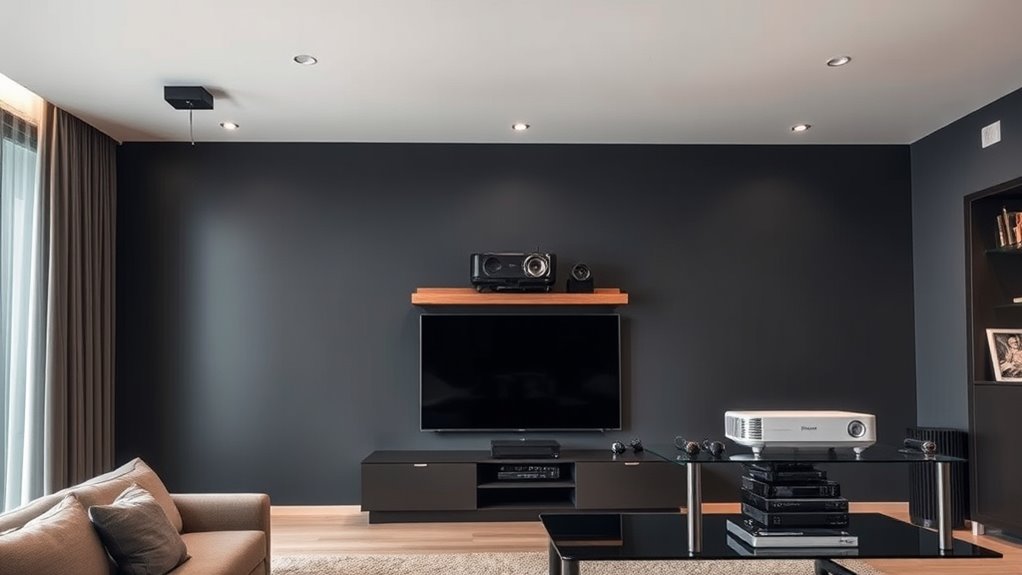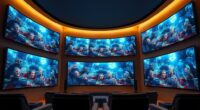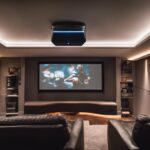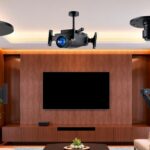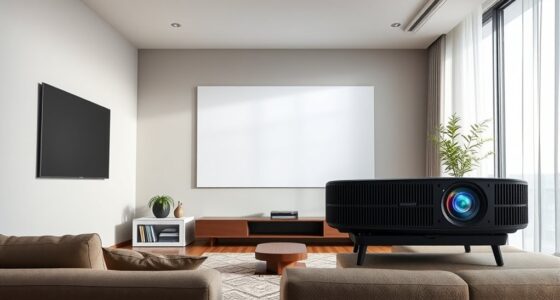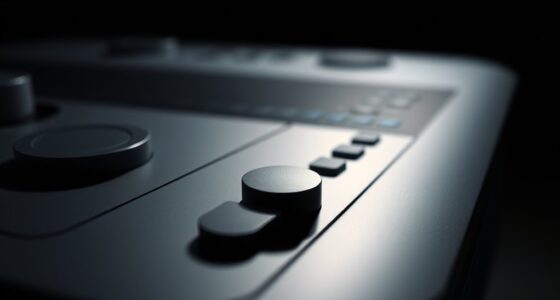When choosing between ceiling, shelf, or table mounting for your projector, consider your space, stability needs, and flexibility. Ceiling mounts provide a secure, fixed position with professional alignment and minimal clutter, ideal for permanent setups. Shelves offer more flexibility but require sturdy support and careful placement to avoid shifting. Tables are easiest but may sacrifice stability and clarity. Exploring your options further will help you find the best fit for your setup.
Key Takeaways
- Ceiling mounting offers stability, professional appearance, and precise alignment, ideal for permanent setups.
- Shelf or table mounting provides flexibility and easy repositioning but may require sturdy furniture for stability.
- Proper cable management is crucial in ceiling mounts for a clean look and preventing damage, whereas shelves may need additional routing.
- Ceiling mounts maximize space efficiency and minimize clutter, while shelf/table mounts are easier to install and adjust temporarily.
- Consider room layout, projector weight, and desired permanence when choosing between ceiling, shelf, or table mounting options.

Mounting your projector correctly is vital to achieving a clear, professional-looking image and ensuring safety. Whether you choose ceiling mounting, a shelf, or placing it on a table, proper setup is key to perfect projection alignment and effective cable management. When considering ceiling mounting, you gain the advantage of a fixed position that minimizes movement and maximizes stability. This setup allows you to fine-tune your projection alignment precisely, ensuring the image is perfectly centered and proportioned on your screen or wall. To do this effectively, you’ll need to use a sturdy mount that supports your projector’s weight and allows for adjustments in tilt and rotation. Proper projection alignment is essential here, as even slight misalignments can distort the image or cause keystone effects. Take your time to align the projector so that the image is square and focused, which reduces the need for frequent adjustments later. Additionally, understanding the projection distance helps determine the optimal placement for your projector to achieve the desired image size and clarity.
Proper projector mounting ensures a sharp image, stability, and safety for a professional viewing experience.
Cable management becomes especially important when ceiling mounting. You’ll want to run cables discreetly through the ceiling or along the mount to avoid clutter and potential tripping hazards. Using cable conduits or clips helps keep cords organized and out of sight, giving your setup a clean, professional appearance. Ensure that the cables are long enough to reach your power source and any other connected devices without strain, but not so long that they sag or create clutter. Proper cable management not only enhances aesthetics but also prevents accidental disconnections or damage to your cables over time.
If you opt for a shelf or placing your projector on a table, you’ll have more flexibility in positioning, but stability becomes a concern. A sturdy shelf or table ensures your projector stays fixed in place, helping maintain projection alignment. However, you’ll need to be vigilant about securing the projector against accidental bumps or knocks, which could shift the image or cause misalignment. When setting up on a shelf, make sure it’s level and stable. For table placement, use adjustable feet or padding to prevent slipping and to fine-tune the angle for better projection. Cable management remains essential regardless of the mounting choice—use clips, ties, or sleeves to keep cords organized and prevent accidental disconnection or tripping hazards.
Ultimately, your choice depends on your space, budget, and desired flexibility. Whichever mounting method you select, focus on achieving precise projection alignment and keeping cables neatly managed. Doing so guarantees a sharp, bright image and a safe, clutter-free environment. Proper setup not only improves your viewing experience but also extends the lifespan of your equipment by reducing unnecessary wear and tear.
Frequently Asked Questions
Which Mounting Option Offers the Best Image Stability?
Ceiling mounting offers the best image stability because it minimizes image jitter caused by vibrations or accidental knocks. It also provides superior mounting durability, keeping the projector securely in place over time. You don’t have to worry about shifting or tilting, which can happen with shelf or table setups. For consistent, clear images, ceiling mounting is your best option, ensuring the projector stays steady and performs reliably.
How Do I Prevent Projector Overheating in Different Mounts?
Overheating can turn your projector into a fiery dragon if you don’t follow proper steps. To prevent this, verify proper ventilation requirements are met, especially in enclosed mounts. Keep the cooling fan efficiency high by regularly cleaning air vents and avoiding obstructions. Whether on a ceiling, shelf, or table, maintaining airflow is key. Use external fans if necessary, and position your projector away from heat sources to keep it cool and functioning perfectly.
Are Ceiling Mounts Compatible With All Projector Sizes?
Ceiling mounts aren’t compatible with all projector sizes. You need to take into account your projector’s weight and make certain the ceiling mount can support it securely. Check the ceiling compatibility, especially if your ceiling has specific material or structural limitations. Always verify the mount’s weight capacity against your projector’s weight, and choose a mount designed for your projector’s size and shape to ensure a safe, stable installation.
What Safety Precautions Are Needed for Shelf-Mounted Projectors?
You need to make certain your shelf-mounted projector is secure by checking the shelf material and weight capacity. Use sturdy, wall-mounted shelves made of strong materials like wood or metal, and confirm they can support your projector’s weight. Mount the shelf at a safe height, and use appropriate anchors and brackets. Regularly inspect the mounting to prevent accidents, and avoid placing the projector where it could fall or be knocked over.
How Does Mounting Type Affect Projector Maintenance Access?
Mounting type directly impacts your maintenance access. Ceiling mounts can make adjustments tricky, leading to alignment challenges, and may require a ladder or scaffolding. Shelf mounts usually allow easier access for maintenance, making it simpler to clean or adjust the projector. Aesthetic considerations also come into play; a shelf mount often looks neater and more accessible, reducing the hassle during routine upkeep. Choose your mount based on ease of access and visual appeal.
Conclusion
Choosing the right mounting option depends on your space, budget, and viewing preferences. Ceiling mounts offer a sleek look and save space, shelves provide flexibility, and tables are the easiest to set up. So, which setup will give you the best movie nights? Think about your room’s layout and how you want to use your projector. No matter your choice, enjoy your home theater experience — it’s all about making your viewing as comfortable and enjoyable as possible.
